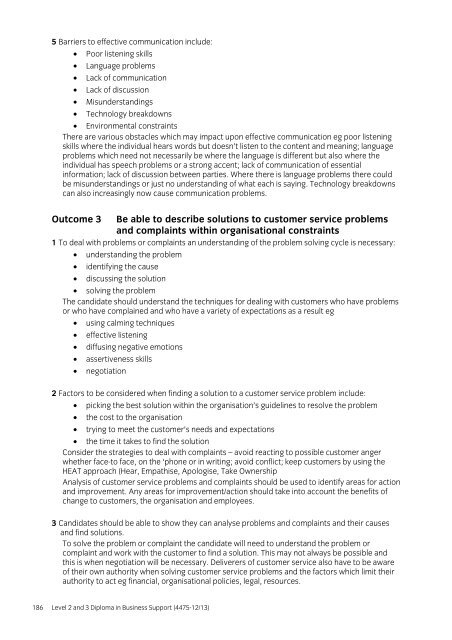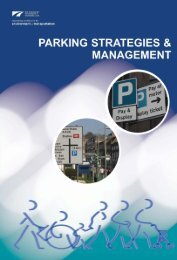Level 2 and 3 Diploma in Business Support (4475-12/13)
Level 2 and 3 Diploma in Business Support (4475-12/13)
Level 2 and 3 Diploma in Business Support (4475-12/13)
You also want an ePaper? Increase the reach of your titles
YUMPU automatically turns print PDFs into web optimized ePapers that Google loves.
5 Barriers to effective communication <strong>in</strong>clude:<br />
• Poor listen<strong>in</strong>g skills<br />
• Language problems<br />
• Lack of communication<br />
• Lack of discussion<br />
• Misunderst<strong>and</strong><strong>in</strong>gs<br />
• Technology breakdowns<br />
• Environmental constra<strong>in</strong>ts<br />
There are various obstacles which may impact upon effective communication eg poor listen<strong>in</strong>g<br />
skills where the <strong>in</strong>dividual hears words but doesn’t listen to the content <strong>and</strong> mean<strong>in</strong>g; language<br />
problems which need not necessarily be where the language is different but also where the<br />
<strong>in</strong>dividual has speech problems or a strong accent; lack of communication of essential<br />
<strong>in</strong>formation; lack of discussion between parties. Where there is language problems there could<br />
be misunderst<strong>and</strong><strong>in</strong>gs or just no underst<strong>and</strong><strong>in</strong>g of what each is say<strong>in</strong>g. Technology breakdowns<br />
can also <strong>in</strong>creas<strong>in</strong>gly now cause communication problems.<br />
Outcome 3 Be able to describe solutions to customer service problems<br />
<strong>and</strong> compla<strong>in</strong>ts with<strong>in</strong> organisational constra<strong>in</strong>ts<br />
1 To deal with problems or compla<strong>in</strong>ts an underst<strong>and</strong><strong>in</strong>g of the problem solv<strong>in</strong>g cycle is necessary:<br />
• underst<strong>and</strong><strong>in</strong>g the problem<br />
• identify<strong>in</strong>g the cause<br />
• discuss<strong>in</strong>g the solution<br />
• solv<strong>in</strong>g the problem<br />
The c<strong>and</strong>idate should underst<strong>and</strong> the techniques for deal<strong>in</strong>g with customers who have problems<br />
or who have compla<strong>in</strong>ed <strong>and</strong> who have a variety of expectations as a result eg<br />
• us<strong>in</strong>g calm<strong>in</strong>g techniques<br />
• effective listen<strong>in</strong>g<br />
• diffus<strong>in</strong>g negative emotions<br />
• assertiveness skills<br />
• negotiation<br />
2 Factors to be considered when f<strong>in</strong>d<strong>in</strong>g a solution to a customer service problem <strong>in</strong>clude:<br />
• pick<strong>in</strong>g the best solution with<strong>in</strong> the organisation’s guidel<strong>in</strong>es to resolve the problem<br />
• the cost to the organisation<br />
• try<strong>in</strong>g to meet the customer’s needs <strong>and</strong> expectations<br />
• the time it takes to f<strong>in</strong>d the solution<br />
Consider the strategies to deal with compla<strong>in</strong>ts – avoid react<strong>in</strong>g to possible customer anger<br />
whether face-to face, on the ‘phone or <strong>in</strong> writ<strong>in</strong>g; avoid conflict; keep customers by us<strong>in</strong>g the<br />
HEAT approach (Hear, Empathise, Apologise, Take Ownership<br />
Analysis of customer service problems <strong>and</strong> compla<strong>in</strong>ts should be used to identify areas for action<br />
<strong>and</strong> improvement. Any areas for improvement/action should take <strong>in</strong>to account the benefits of<br />
change to customers, the organisation <strong>and</strong> employees.<br />
3 C<strong>and</strong>idates should be able to show they can analyse problems <strong>and</strong> compla<strong>in</strong>ts <strong>and</strong> their causes<br />
<strong>and</strong> f<strong>in</strong>d solutions.<br />
To solve the problem or compla<strong>in</strong>t the c<strong>and</strong>idate will need to underst<strong>and</strong> the problem or<br />
compla<strong>in</strong>t <strong>and</strong> work with the customer to f<strong>in</strong>d a solution. This may not always be possible <strong>and</strong><br />
this is when negotiation will be necessary. Deliverers of customer service also have to be aware<br />
of their own authority when solv<strong>in</strong>g customer service problems <strong>and</strong> the factors which limit their<br />
authority to act eg f<strong>in</strong>ancial, organisational policies, legal, resources.<br />
186 <strong>Level</strong> 2 <strong>and</strong> 3 <strong>Diploma</strong> <strong>in</strong> Bus<strong>in</strong>ess <strong>Support</strong> (<strong>4475</strong>-<strong>12</strong>/<strong>13</strong>)







